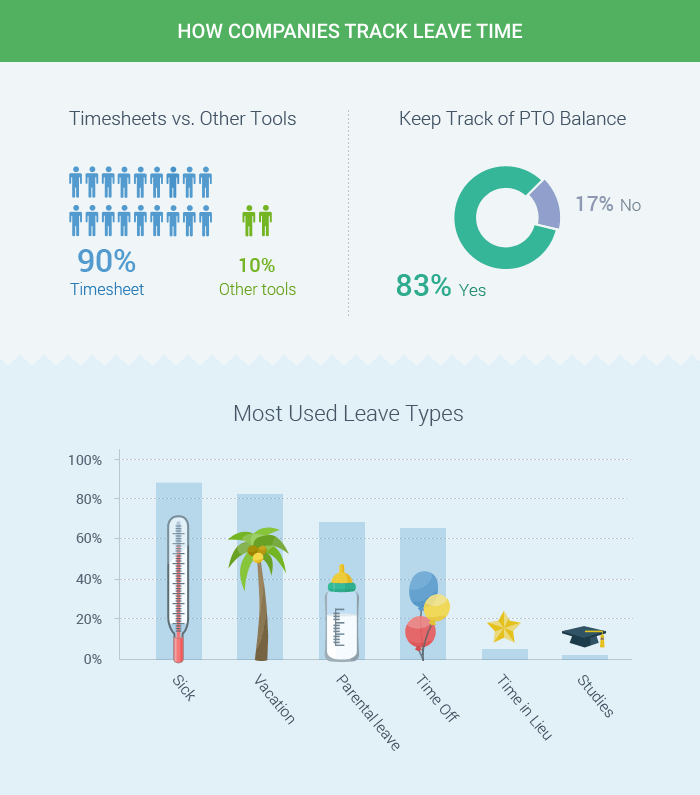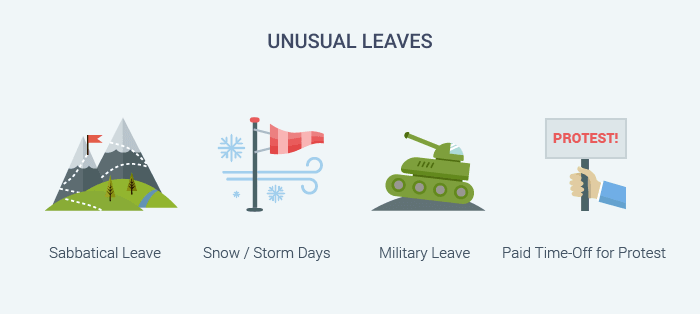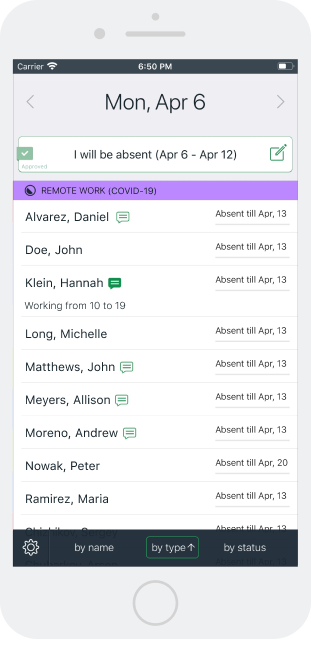When it comes to vacation policies, approaches vary significantly from state to state and country to country, as there is no universal law governing paid vacation days across nations, leading to a patchwork of policies that can differ not only between countries but also within firms located in the same region.
While some organizations adhere strictly to basic types of employee leave to accrue paid time off (PTO), others create elaborate leave calculation systems with multiple unconventional categories—think duvet days or even bad mood leave.
The choice of approach hinges on several factors, including internal organizational culture, regional regulations, cultural norms, and even external influences like the COVID-19 pandemic, for example. These elements shape how businesses think about time off and the importance they place on employee well-being.
In this post, we’ll explore both conventional and unconventional leave types, offering insights into how you can enhance your team’s benefits and demonstrate that you are a caring employer.
Most Prevalent Types of Employee Leave
Our recent data analysis revealed that 83% of companies actively monitor their employees’ PTO balances using either time-tracking or leave management software, underscoring the importance of keeping track of time off.
These tools not only streamline the process but also provide flexibility in managing various types of paid time off. They may contain a plethora of leave classes, from public holidays to very peculiar sorts of time off taken to satisfy various personal or public interests.
But let’s begin with the basics. The 8 most commonly used types of leave of absence are as follows:
1. Vacation (Annual Leave)
Across the globe, officially employed workers are entitled to several weeks of paid time off each year. Companies have valid reasons for granting employees ample vacation time—taking a well-deserved break helps individuals recharge, feel refreshed, and return ready to tackle new challenges. However, businesses in various countries and U.S. states provide different annual leave options, with some being more generous than others.
For instance, in California, accrued vacation time is equated to regular wages already earned by employees. It means that a fixed holiday period cannot expire, whereas unused PTO balances ought to be paid after contract termination. In contrast, employers in Pennsylvania are not required to give their employees any vacation benefits. Therefore, the provision of both paid and unpaid leave benefits rests entirely upon local companies’ internal policies.
2. Sick Leave
In short, sick leave is the time taken to recover from a disease. At the national level in the United States, employees do not have a legal right for paid medical leave. However, the Family and Medical Leave Act (FMLA) obliges companies with teams of 50 and more members to provide up to 12 weeks of unpaid time off to those in need of attending to their own health or the health of a family member.
At the same time, many European, South American and Asian countries make the payment for sick days mandatory. In the Netherlands, for example, employees recovering from a disease may be absent for up to 2 years and receive a minimum of 70% of their regular salary during this time.
3. Maternity Leave
Maternity leave refers to the time a mother takes off from her job to care for her newborn. Similar to other types of leave in the United States, many employers are not legally obligated to provide paid maternity leave. However, under the Family and Medical Leave Act (FMLA), women in the U.S. are entitled to take up to 12 weeks of unpaid maternity leave.
In contrast, working mothers in Estonia are among the luckiest female employees in the world. They can stay home and take care of their newborn babies for up to 18 months after birth and be fully paid for it.
4. Paternity Leave
A father has a chance to take this type of leave after the birth or adoption of a child. The most generous paternity leave regulation among developed countries is currently enacted in Japan. The Japanese government allows new dads to enjoy up to 30 weeks of PTO at their regular salary rate.
In contrast, fathers (and mothers) in the United States can expect to be partially paid when staying at home and caring for their children only in 8 states:
- California
- New York
- New Jersey
- Washington
- Rhode Island
- Oregon
- Massachusetts
- Connecticut
5. Personal Time Off
When an employee needs to manage some private matters, they are allowed to take personal leave. It is suitable for a wide range of situations: short-term hospital visits, handling of a divorce or traveling to the best friend’s wedding. Overall, this kind of time off could be utilized to participate in different events and activities that are not related to work but cannot be postponed.
If an employee thinks of taking a break to address these private matters not as part of mandatory annual leave, it will likely remain unpaid.
6. Bereavement Leave
Bereavement leave is given to employees who are going through the trauma of losing an immediate family member or are dealing with a life-threatening condition of the latter. Also known as compassionate leave, this category of time off is crucial for individuals experiencing some of the hardest moments in their lives, and employers do a wise thing providing them with enough time to recover – mentally and emotionally broken employees cannot be productive. Therefore, bereavement assistance is always a part of PTO policies in people-oriented organizations.
7. Time Off in Lieu (TOIL)
“In lieu” means “instead of” and, in TOIL, it indicates that compensation for overtime work can be taken as time off instead of monetary payment. All in all, TOIL policies are closely interrelated with organizational overtime regulations. In other words, you will have an opportunity to receive more leave time for extra hours spent at work merely if your employer compensates workers for overtime on a regular basis.
Business owners should take into account that in companies with well-established TOIL management systems, employees tend to have more positive attitudes to overtime work. As a result, they may show better productivity outcomes.
8. Public Holidays
The list of federal holidays varies from one country to another, and, in a vast majority of cases, employers provide their subordinates with PTO during those days. In the United States, for instance, 97% of companies offer PTO to their workers during Thanksgiving, although they are not legally required to do so either for this or for any other public holiday.
In contrast, in Singapore, employees are officially entitled to have paid leave time during 11 federal holidays. In case a person has to show up at the workplace during any of them, he or she usually receives a double-rate remuneration or a day-worth TOIL.

Unusual Leave Types
This section explores those kinds of time off that are either used by a relatively small number of people or are defined by specific cultural and environmental factors. Here are 9 of them:
1. Sabbatical Leave
Sabbatical leave is the most common among the unconventional types of time off. Initially, it was practiced only by employees of educational institutions and enabled them to use a long-term period off duty to engage in some personal endeavors, such as research or studies, while staying employed.
Nowadays, sabbatical leave is gaining popularity among private companies as well. Based on the results of the SHRM survey, 10% of organizations had unpaid sabbatical programs in 2018, and 5% of firms had the paid ones. As such, this kind of time off can be rightfully regarded as an excellent form of reward for employees’ achievements and contributions.
2. Leave of Religious Observance
This type of leave is granted to workers who seek to fulfill their religious needs and usually falls under the category of unpaid time off. The rules on how many religious observance days one can take depend on their congregation’s religious calendar.
For instance, those professing Judaism in the Australian state of Victoria can receive a maximum of 13 unpaid days off to participate in festivals and abide by religious traditions. However, to get their leave request approved, employees are usually asked to provide relevant evidence, such as faith membership.
3. Adverse Weather Leave
In extreme weather conditions, it becomes difficult (and often impossible) to travel to work. Therefore, on days of severe climatic events, employees frequently have official time off.
Since staying at home isn’t a personal choice but a necessity during a bad weather period, employers are generally required to pay their staff even if their business facilities get temporarily closed. In such circumstances, managers sometimes require employees to make the lost time up later or to do their jobs from home because these measures aid in preventing financial loss.
4. Military Leave
When an employee performs active military duty, they are entitled to military leave days for hours that otherwise would be spent at the workplace. This type of time off is used in many countries across the globe. One of them is Switzerland, where basic military training takes 21 weeks, during which an employed individual receives up to 80% of their regular salary.
American companies are also obliged to keep track of their employees’ military service. Nevertheless, not all of them prefer to pay for military leave taken.
5. Time Off for Protests
In democratic states, to openly express opposition to some of the government’s choices is a norm. Thus, on the day of a big protest, a politically active individual may decide to take a leave.
Not that long ago, several Silicon Valley companies made time off for protests a corporate standard. In this way, they let employees stand against President Trump’s decisions to tighten immigration control policies and added an extra benefit for their politically conscious workers.

6. Jury Duty Leave
Jury duty is a standard practice in the United States and several other democratic nations, requiring individuals to be summoned by a court to serve on a jury on a designated day. To accommodate this civic responsibility, employees may take jury duty leave, which is typically included in their paid time off (PTO) balances at companies that encourage active citizenship. However, in some cases, this type of leave may be unpaid and regarded by employers as a form of personal leave of absence.
7. Voting Leave
Another form of leave associated with employees’ civic responsibilities is voting leave. This leave is granted on official election days to ensure that everyone has the chance to participate in the electoral process.
Voting leave is particularly popular in the United States, where various campaigns and mass media sources regularly encourage citizens to go to the polls. Regardless of that, the country’s federal government doesn’t require employers to provide time off for voters, yet in the majority of states, including California and New York, employers must pay for at least 1 hour of their workers’ voting time.
8. Time Off as a Gift
In Japan, when an employee gets married or gives birth to a child, their employer frequently grants them with unpaid time off. Such a practice is not a legal requirement but a beautiful custom. It is a part of the country’s cultural etiquette and is performed to show respect and appreciation to individuals.
9. Self-Quarantine Leave
In the present-day reality of dealing with the COVID-19 pandemic, a growing number of businesses across the globe let employees stay home in order to prevent the spread of the disease. Our company wasn’t an exception.

During the pandemic, as the global situation intensified rapidly, actiTIME, Inc. introduced a new leave category in its corporate actiPLANS account – Remote (COVID). This type of leave was not counted as PTO and was utilized by self-quarantined employees to explain their absence from the office for a specified period. With social distancing becoming an essential recommendation, Remote (COVID) was in particularly high demand among our team members at that time.



